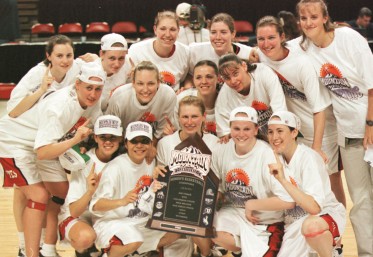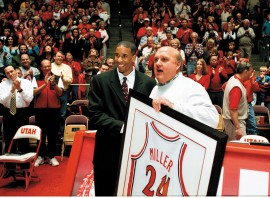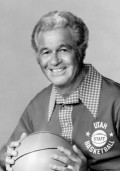
VOL. 10 NO. 1 THE MAGAZINE OF THE UNIVERSITY OF UTAH SUMMER 2000
SIDELINES

by Byron Sims
IT WAS A VERY GOOD YEAR—SORT OF
At season's end, the Utes were co-champions in the first year of the Mountain West Conference, went to the second round of the NCAA Midwest Regional, finished play with a 23-9 record, and had senior forward Alex Jensen named the MWC's Most Valuable Player and a member of Sports Illustrated's "All-Glue-Guy" team.* Yet an aura of disappointment hangs over the season. How can that be?
Because it might have been so much better.
Ute players cumulatively missed some 250 practices because of injuries during the year. Only Jensen stayed healthy. Projected All-America forward Hanno Möttölä missed more than a month with knee, elbow, and thumb ailments. Consequently, Coach Rick Majerus had to consult the team trainer before settling on his lineup. With healthy starters, the Utes might have avoided going 4 and 4 over the last four weeks, including losses to downtrodden Air Force and fast-rising BYU in the MWC tournament.
Whatever the reason, the Utes never achieved juggernaut stature, performing instead like a balky two-cycle engine, snarly at times but often chugging and clanking in a cloud of blue smoke.
Thanks to their late-season inconsistency, the Utes entered the Regionals as a No. 8 seed; earlier, they had reason to anticipate a No. 2 spot. They sputtered to a 48-45 win over Saint Louis despite shooting a frigid 38 pct. in field goals and an atrocious 47 pct. on free throws. Then, with injuries sidelining one starter and hobbling another, Utah faced healthy and No. 2-ranked Michigan State.
The game was nearly a reprise of Utah vs. Kentucky for the national championship two years ago. In the first half, the engine was purring and Utah looked like the team it might have been, smoothly breaking out to a three-point lead. But in the second half, MSU's Spartans put together a 14-point run over eight minutes to go up by six, eventually subduing the stubborn but outmanned Utes, 71-63. Seniors Jensen, Möttölä, and guard Tony Harvey, all playing their last game for Utah, scored 13, 16, and 15 points respectively.
Next year's squad will include transfer Chris Burgess, redshirt Nick Jacobson, and returned missionaries Britton Johnsen and Trace Caton, along with veterans Nate Althoff, Jeff Johnsen, Phil Cullen, and some touted recruits.
(*SI magazine characterized its choice of "glue guys" as versatile, selfless heroes who hold their teams together so they can stick it to opponents.)
UTE WOMEN HAD A MIGHTY GOOD RUN
 Utah
had two Mountain West Conference champions this year, two teams that won
23 games, and two teams that went to a NCAA tournament.
Utah
had two Mountain West Conference champions this year, two teams that won
23 games, and two teams that went to a NCAA tournament.
Even though Utah was eliminated in the tourney's first round for the ninth time, it does not diminish the fact that Coach Elaine Elliott's teams have appeared 10 times in the postseason playoffs.
This time, Utah fell victim to Illinois, 77-58, when a strategic matchup paid off. The Illini assigned 6'1" Tauja Catchings to defend Tiana Fuertes, Utah's point guard who had been Most Valuable Player in the conference tournament. Fuertes stands 5'3". Catchings nearly took the Utes' key player out of the game; Fuertes had seven of her team's 21 turnovers. However, when Catchings fouled out with nearly nine minutes left, Utah closed from a 58-39 deficit to 63-56 in five minutes before their comeback fell short.
Fuertes is one of only two seniors on Elliott's squad.
IT'S MILLER, TIME AND AGAIN
Andre Miller BS'98, the former All-American rated by Coach Rick Majerus as the Utes' best-ever point guard, essentially slam-dunked the basketball world during a series of highlights in early February.

Now a rookie with the NBA's Cleveland Cavaliers, Miller reached three successive pinnacles—within a single week. First, in just his second start for Cleveland, Miller posted a triple-double—28 points, 12 rebounds, 10 assists—in 47 draining minutes as the Cavs lost to the Atlanta Hawks. How tough is that to attain? To compare, John Stockton, the Utah Jazz's consummate point guard, has exactly zero triple-doubles in his illustrious career.
Then Andre returned home to the Huntsman Center, and in front of a sellout crowd awaiting the U-BYU game, accepted a framed jersey commemorative of his number (24) being retired. Only the sixth Ute to be so honored, Miller joins Billy McGill (12) 1960-62, Arnie Ferrin (22) 1944-48, Danny Vranes (23) 1977-81, Vern Gardner (33) 1946-49, and Keith Van Horn (44) 1993-97.
Finally, three days later, Miller appeared in the Rookie Challenge game that precedes the annual NBA All-Star Game. While exhibitions of dunking and diving, juking and jiving swirled about him, Miller racked up a workmanlike game-high 21 points—and got booed.
On a breakaway play, Miller disdained an open dunk for a simple layin, as his coach had taught him. But the callous crowd at Oakland, perhaps a bit jaded by an otherwise over-amped display of aerobatics, let Miller know its disappointment each time he touched the ball. After the game, Miller quietly remarked, "You've got some guys that are flashy and athletic. Then you have the guys that just like to go out and play basketball. I'm one of those guys."
His comment is validated by New York Knicks' coach Jeff Van Gundy's observation: "Andre Miller isn't good, he's great. He was taught so well in college that he came out with a great understanding of the game and how to play."
RIVALRY IS ONE FOR THE BOOKS
When the Utes and Cougars met in their third shootout of this season, a bit of history was on the line. Utah and BYU have a basketball series that extends over 91 years, starting when Teddy Roosevelt was vacating the White House. After 228 meetings, each side has 114 wins. The Utes first broke the tie with a convincing home-floor victory, then the Cougars responded with an upset win in the Mountain West Conference tournament.
Over the years Utah has played 274 different opponents, yet the only tie in any series was the one with BYU. However, the Utes had won 12 straight games with the Cougs, marking the longest winning streak of the rivalry. BYU had won eight of the previous 10 games.
"If one measure of a rivalry is how even the competition is," a Deseret News sports columnist observed, "then this rivalry has greatness." His column also included these statistical notes on the series:
The home team has won 129 times; there have been 14 overtime games; the season series has been even 24 times; Utah has 26 sweeps, BYU 21; BYU has won 10 one-point games, Utah 9; in two-point games, Utah has 11 wins, BYU 10.
Can't slice it much finer than that.
BUD'S GONE, BUT HIS LEGACY IS EVER PRESENT
If "Bud" Jack BS'39 had attended his own memorial service at Rice-Eccles Stadium in February, he could have looked down on much of the campus legacy he created during his nearly 30 years in Ute athletics.
 Jack
died at age 81 of causes incident to age and diabetes.
Jack
died at age 81 of causes incident to age and diabetes.
He was a central figure
in the planning and fund-raising for the erstwhile Special Events Center, now the Huntsman Center, which was dedicated in 1969. Jack also helped oversee the first major renovation of outdated Ute Stadium, which included artificial turf on the field and the addition of the first scholarship box. The facility was subsequently renamed Rice Stadium to honor benefactor Robert L. Rice. The name was later changed to Rice-Eccles Stadium.
Jack served successively as manager of student activities, athletics ticket and business manager, and assistant athletics director. He was athletics director from 1958 until 1976. In 1962 he was a key player in the formation of the Western Athletic Conference and chaired the radio-TV committee until his retirement. During his tenure, the women's collegiate athletic program was fully established.
Jack played a major role in bringing the 1979 NCAA Final Four Tournament to the U, which spotlighted Hall of Famers Larry Bird and Magic Johnson and remains the top-rated final tourney in NCAA history. He was president of the National Athletic Directors Association, was inducted into the group's hall of fame, and received its highest award.
Jack's name is in the Utah Sports Foundation Hall of Fame and the U of U Crimson Club Hall of Fame, and he received the Merit of Honor Award from the University's Emeritus Alumni Association.
He was a member of the U.S. Olympic Committee from 1965 to 1981, and served for eight years as the NCAA committee representative. He was transportation chair for four Olympics and was chief of the U.S. Mission for the 1980 Summer Games in Moscow, eventually boycotted by the U.S.
Bud's wife, Ila, was also closely associated with Ute athletics until her death in 1993.
 EX-UTE
TENNIS STAR DIES
EX-UTE
TENNIS STAR DIES
Dick Bennion BS'38, who died at 81 in mid-March, won the tennis singles and doubles championships for three straight years when he played for the Utes from 1935 to 1938. Also, he was conference broad-jump champion as well as student body president. Bennion was one of the first inductees to the Utah Tennis Association Hall of Fame and entered the Crimson Club Hall of Fame in 1997. All three of his sons—Rick, Scott, and Bill—lettered in tennis at the U.
REMEMBERING "THE FOX"
He came from the flatlands and stirred up a storm in the mountains. For 18 years, Coach Jack Gardner sat on the sidelines, swigged his milk, waved his hanky, and confounded his opponents, as reflected by the 339-154 record his Ute teams compiled between 1953 and 1971, along with seven conference titles. Including his previous 10 years at Kansas State, Gardner was the only coach to take teams at two different schools to the Final Four two times each.
 Respectfully
known as "The Fox," Gardner was inducted into the National Basketball
Hall of Fame in 1984. Four years ago, a commemorative plaque in his honor
was placed outside the home team locker room in the Huntsman Center.
Respectfully
known as "The Fox," Gardner was inducted into the National Basketball
Hall of Fame in 1984. Four years ago, a commemorative plaque in his honor
was placed outside the home team locker room in the Huntsman Center.
In April the whistle finally blew for Coach Gardner. He died at age 90, two weeks after his birthday and four days after the death of longtime rival Stan Watts, who coached at BYU during Gardner's tenure at the U.
At Kansas State, Gardner created the "triangle offense" employed so successfully in recent years by the Michael Jordan-led Chicago Bulls and still evident today under Los Angeles Lakers' assistant coach Bill Winters, a Gardner protégé at K-State. At Utah Gardner's fast-break offense spawned the affectionate nickname of Runnin' Redskins, later changed to Runnin' Utes. His teams averaged 22 wins in his first eight years at the U and won 70 percent of their games overall. In 1961-62 Billy "The Hill" McGill led the nation in scoring at nearly 39 points per game, including a 60-point personal outburst against BYU. In 1965-66 the Utes put up 131, 128, 127, and 122 points respectively against New Mexico State, Morehead State, Utah State, and Hawaii. When Gardner waved his hanky, the Utes took a time-out. When games got dicey, Gardner gulped milk from a bottle beneath his chair to sooth an anxious stomach.
"The Fox" coached 11 All-Americans and mentored 22 men who would later become head coaches. His basketball career took him to 42 countries, and for 58 years he attended every Final Four game. After retiring from coaching in 1971, Gardner was the U's golf coach for seven seasons.
As a consultant with the Utah Jazz in later years, Gardner had the distinction of suggesting the Jazz use their first-round pick in 1984 to draft a virtually unknown player. His name was John Stockton.
Good eye, Coach.
TALENT, AND BAGGAGE
After extensive research into his troubled past, the Utes accepted Salt Lake Community College's star point guard Travis Spivey, who will be eligible to play next fall. He had been the recruiting target of Utah's coaches but had to win approval from the U administration, and met personally with President Bernie Machen. Spivey started as a freshman at Georgia Tech before transferring to Iowa State. He pleaded guilty to statutory rape in Iowa and received a 10-year suspended sentence. After his transfer to SLCC, he averaged 18 points and had six triple-doubles in one season.
SCHMOOZE, LUCK, AND TALENT
Successful football recruiting depends on a number of elements: a program of promise, perceptive scouting, aggressive but honest selling, the personal touches that win over moms and impress dads, and an emphasis on academics.
And don't discount buddies and bloodlines.
In what has been called a "monstrous" recruiting class this year, Coach Ron McBride, who embodies the elements listed above, also had some good luck. For instance, the Utes landed a couple of burly "bookend" linemen out of St. George. Paul and Scott Fisher are brothers—take one, you get the other.
Quarterback Brett Elliott, Gatorade's Player of the Year in Oregon, was a prize catch for the Utes. While visiting another school, Elliott roomed with running back Tommy Hackenbruck, the Portland Oregonian's choice for offensive player of the year. When Elliott later opted for Utah, he suggested that his roomie consider doing the same. "I visited the campus in January and knew right away that was where I belonged," says Hackenbruck. Got one, you get the other.
Offensive lineman Steve Dahl is a 317-pound product of Skyline High's championship program in Salt Lake City whose dad was a Ute tackle in the '70s. He committed to Utah last fall, then "leaned on" some teammates. Result: kick returner/DB Bo Nagahi and RB Rob Sirstins are now in the Ute fold. Nagahi, an electrifying runner, had been considering Stanford. But bloodlines and 300 pounds of pal pressure paid off. Besides, says Dahl, who loves to knock over players like bowling pins, "I wanted to go to a team that will run, not just pass, pass, pass."
The new Utes include 10 who will serve church missions before playing and a number of others who will "grayshirt," meaning they'll pay their own way to attend school until scholarships open up from next year's graduating class.
Copyright 2000 by The University of Utah Alumni Association